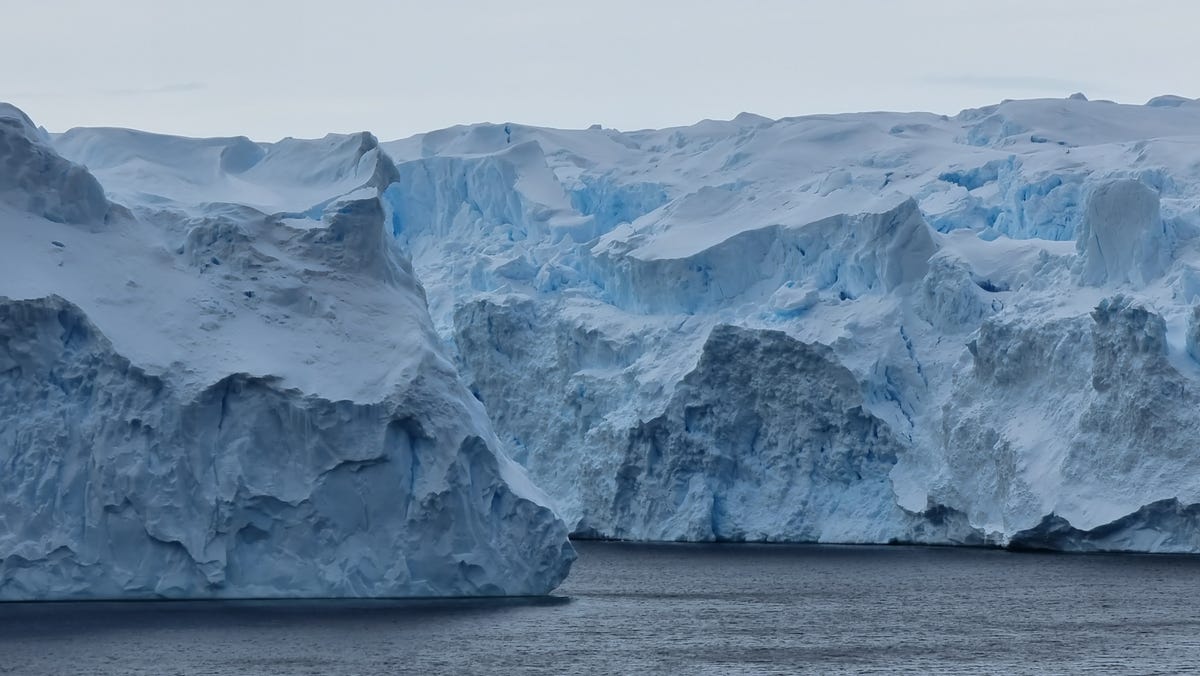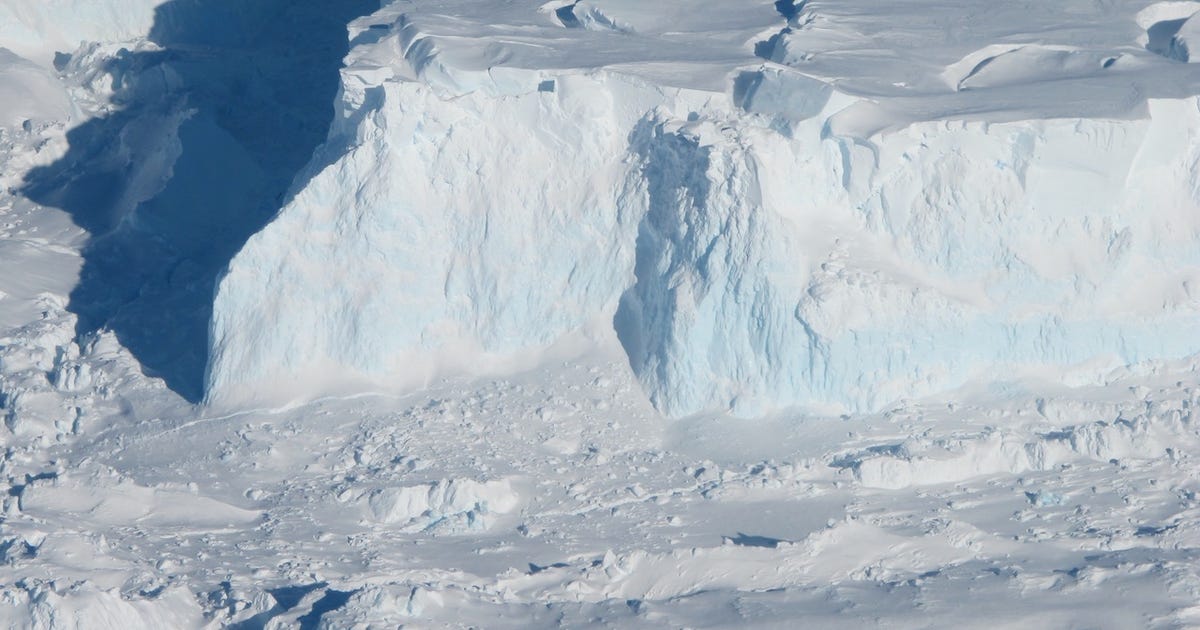Antarctica’s Thwaites Glacier, the widest on Earth, is in trouble.
The glacier extends out into the Southern Ocean and is losing about 50 billion tons of ice per year, with that loss doubling over the last 30 years. In 2019, NASA scientists discovered a huge cavity beneath the glacier, about two-thirds the size of Manhattan, which could speed up the glacier’s demise. This week, researchers mapped the ocean floor in front of Thwaites, showing the glacier had rapidly retreated in the past — and suggesting a small kick might accelerate its retreat once more.
This is worrying. If Thwaites melts, sea levels would rise about 25 inches. Its demise could also destabilize the West Antarctic Ice Sheet, which locks away around 10 feet of sea level rise. That kind of melting would be catastrophic.
With every new study, we learn more about Thwaites’s vulnerability. And with every new study we see Thwaites back in the news cycle, largely thanks to its powerful and alarming nickname: “The Doomsday Glacier.”
But that nickname, though it has generated mountains of press exploring the fate of Thwaites, might actually do more harm than good. It’s a moniker glaciologists and scientists shy away from using — so why is it so pervasive in the mainstream press? Should we keep using it? And why does it matter?
Doom and Gloom
On May 9, 2017, Rolling Stone published a deeply-researched and brilliantly-written piece about Thwaites by climate writer Jeff Goodell. It had a simple, powerful headline: “The Doomsday Glacier.” It’s perfect for the story. But the nickname stuck.
Today, publications repeat the line ad nauseum whenever a significant new study about Thwaites is published. Some stories suggest Thwaites is known as the Doomsday glacier in “scientific circles” because its disintegration could lead to catastrophic sea level rise of more than 3 to 10 feet. That’s not quite the case.
We don’t know for sure how Thwaites’ disintegration would change sea levels in the short-term. The glacier itself locks up about 25 inches of sea level rise, but most stories use the 3 to 10 feet range. This is actually referring to the entire West Antarctic Ice Sheet being lost.
And though extensive research shows Thwaites is in trouble, it’s not the scientists or glaciologists or polar experts that are throwing around the nickname. I spoke to a number of experts associated with glaciology and polar research who all highlighted the fate of Thwaites is increasingly concerning. However, most had mixed feelings about the doomsday moniker, with many averse to using the title at all.
“I discourage the use of the term ‘Doomsday Glacier’ to refer to Thwaites Glacier,” said Ted Scambos, a glaciologist at the University of Colorado, Boulder and member of the Thwaites Glacier Collaboration. Scambos suggested “wild card glacier” or “riskiest glacier” might be used in its place.
One of the chief reasons scientists feel uneasy about the phrase is that it suggests we’re already doomed. “We are not,” said Eric Rignot, an Earth scientist at NASA’s Jet Propulsion Laboratory. The doom and gloom narrative feeds into a sense that we’ve already past the point of no return, that Thwaites is already lost which can, more broadly, lead to inaction. The moniker gives us the wrong idea.
“It’s kind of too alarmist,” noted Helen Fricker, a glaciologist at the Scripps Institution of Oceanography.
Rignot said we could still slow down the retreat of Thwaites if we take proper action on climate but “time is running out.” That’s a little less severe than doomsday, of course.
Another reason “doomsday” might not be a great moniker is because it obscures the larger problem facing the Earth’s frozen areas — the “cryosphere.” Human-induced climate change and the burning of fossil fuels has caused glacial retreat across the planet.
“On the one hand, it is a wake up call, aka take these things seriously,” said Rignot. “On the other hand, it summarizes the situation as if there was only one bad glacier out there.”
Rignot explains there are glaciers across the world — in East Antarctica and Greenland, for instance — which lock up far more water. If those were to disintegrate and disappear, sea level rise could be an order of magnitude greater than what we might see with Thwaites.
The study this week in Nature Geoscience, led by glaciologist Robert Larter at the British Antarctic Survey, shows how precarious the situation is and how much faster than expected Thwaites might retreat. But even Larter shies away from using the word “Doomsday.”
That’s not to say Thwaites isn’t important.
“Thwaites is obviously not the only glacier that matters, but it is objectively the most concerning glacier on Earth in terms of its potential to generate large amounts of sea level rise in the future,” said Andrew Mackintosh, a glaciologist at Monash University.
So should we keep using “Doomsday Glacier”?

The Vanderford Glacier, in East Antarctica, is poorly studied.
Jackson Ryan/CNET
You Can’t Always Get What You Want
In September 2021, coronavirus cases were surging in South Africa. Scientists began detecting a variant of the virus dubbed C.1.2, with a number of mutations, which quickly found its way to the press via preprint studies.
Though the new variant accounted for just 5% of new cases, some publications jumped on the news, describing the variant as “worse than Delta,” and calling it the Doomsday variant.
Doomsday, it seems, can be brought about by many different sources.
The coronavirus scenario is an interesting comparison. By the time the doomsday headlines began circulating, the World Health Organization was already suggesting that C.1.2 was not a variant of concern. That meant it was easy to drop the alarmist name.
For Thwaites, things are a little different. Scientists are concerned about its future. Things are getting worse. Doomsday, in this instance, helps bring attention to the plight of the glacier and may aid in understanding how problematic things have become. And perhaps it’s already too late to change course and rename it. Even the first line of Thwaites Glacier’s Wikipedia page says it’s also known as the Doomsday Glacier.
“There is no getting ahead of the label,” said Scambos. “On the plus side, the public is now aware of the area because of the power of the nickname,” said Scambos.
So, though scientists might not feel all that great about it, we might just be stuck with it. We just can’t let that hide the fact there are many glaciers under threat and the threat is us: If we don’t wean ourselves off fossil fuels, we’ll continue to increase carbon dioxide in the atmosphere and bring about Thwaites demise.
And the real doomsday won’t be the loss of Thwaites. It will be when we disturb areas like East Antarctica, which locks away meters of sea level. If that sheet was lost it would dramatically change the face of the Earth. Fricker says that’s not a future that will come to pass any time soon but if we begin to see dramatic changes in that ice sheet, then that’s when we’re in real trouble.
“That’s doomsday,” she said.

